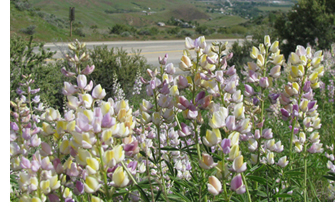

Spread the word about spreading wildflower seeds
 Usually, ITD does not advocate throwing things from the back of a motorcycle, or shooting guns at hillsides. ITD officials generally get nervous when frozen water is put on or near state highways.
Usually, ITD does not advocate throwing things from the back of a motorcycle, or shooting guns at hillsides. ITD officials generally get nervous when frozen water is put on or near state highways.
But occasionally, that behavior is encouraged.
Through the Adopt-A-Highway program, roadside beautification efforts and Operation Wildflower, program coordinator Sherie Sweaney has heard of people using unusual methods to distribute seeds for vegetation projects.
“Some people have been known to hop on a motorcycle and throw the seeds off as they fly down the road,” Sweaney said. “I've heard of them using a battery-powered water pistol to shoot the seeds up steep hillsides. I've heard of freezing the wildflower seeds into ice cubes and then dropping the ice cubes on the hillside, so that as it melts it has a supply of water to get started.”
“People can be very creative,” she explained. “I’ve had folks throw seeds onto fresh snow figuring it will melt in a day or two. With many of the birds having migrated, the seeds find their way into enough soil to grow.”
 Sweaney said it only takes about 1/16 of an inch for the seeds to become established.
Sweaney said it only takes about 1/16 of an inch for the seeds to become established.
Of course, the most mundane way to spread seed also is the most popular - with a spreader or by hand.
California Poppy and Lewis Flax are popular in the early spring in the Treasure Valley of southwest Idaho, while Globe Mallow and Palmer Penstemon often are used in the desert regions in June and July. Fire Cracker Penstemon most often is used in the higher elevations.
The fall months are the most common planting periods for the wildflower program, said Connie Marshall of ITD’s Vegetation Crew. “Planting is often done earlier in the fall, in September and October, since some of the wildflower planting requires minor tilling before the ground is frozen.”
Planting can take place as late as November, since “some seeds require a freeze in order to germinate,” she added.
ITD’s Operation Wildflower features more than 60 groups who plant along the roadsides of the state highways. Seeds are selected based on the variety that grows best in the specific region. Selected varieties are drought-resistant and require little or no water to survive.
Anyone interested in volunteering for the vegetation program can view the left side of ITD’s website at itd.idaho.gov. People also can go to Operation Wildflower to access the program’s information and an application. ITD provides wildflower seeds to volunteer groups in 4-ounce packets.
ITD’s Operation Wildflower Program received a leadership award from the American Association of Motor Vehicle Administrators in the Environmental Partnership category for encouraging and supporting native and desirable wildflower growth to promote highway beautification and aid in erosion and weed control.
Published 10-18-13